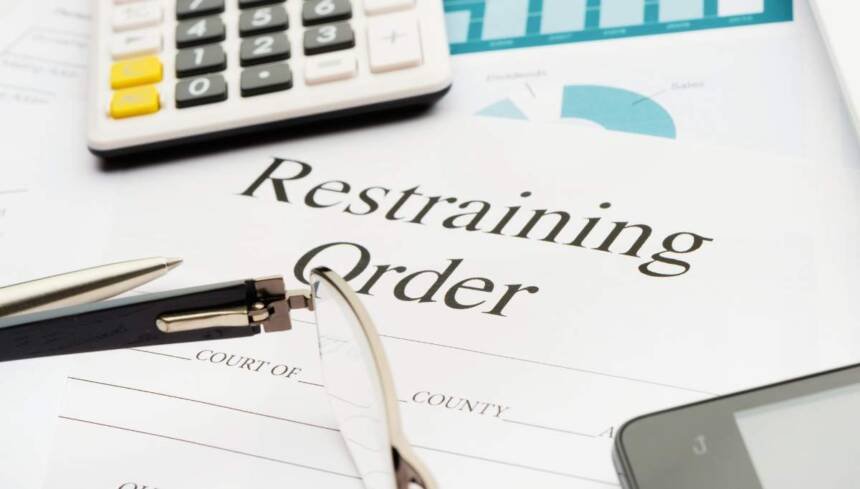There is something called a restraining order that can help you if someone in Texas is making you feel afraid. You can make the best choice for you by reading this guide. It has all the information you need about getting a restraining order in Texas.
What is a Restraining Order in Texas?
One person (the “respondent”) is told by a court in Texas to stay away from another person (the “applicant” or “protected person”) and not do certain things with them. This is also known as a “restraining order” or “protective order.”
Its job is to keep bad things from happening. In Texas, the main goal of a restraining order is to officially protect people and stop things like domestic violence, stalking, and other forms of harassment.
When Can You Get a Restraining Order in Texas?
If you have gone through or are going through this, you may be able to get a restraining order in Texas.
Domestic violence: This includes all forms of abuse – such as physical, sexual, emotional or verbal – perpetrated by someone in your own family or home, such as a spouse, ex-husband or partner.
Stalking: This happens when a person keeps doing things that a normal person would find irritating to themselves or others.
Sexual assault: This includes any sexual content that wasn’t okay, like when someone touches you without permission, makes you uncomfortable with sexual comments, or threatens you with sexual violence.
Dating violence: It’s the same as any type of abuse – physical, sexual, emotional or psychological – occurring in a relationship.
As you probably already know, the relationship between the person seeking a restraining order and the person it is against is very important when it comes to qualifying in Texas. The law lists certain types of relationships that are considered, so it’s good to know where you stand.
The Process of Getting a Restraining Order in Texas
Getting a restraining order in Texas usually includes the following steps, as long as you meet the requirements:
1. Filing the Application:
- A protection order is easy to get. Just go to the district or county court in your area or the person’s area and ask for one.
- On the application, you have to give full details about the abuse, threats, or harassment you experienced, as well as how you know the person you are charging.
2. Temporary Restraining Order:
- The court may decide to give you a temporary restraining order (TRO) to protect you for a short time after they look over your application.
- People who are not in court may still get a TRO if the judge thinks there is still a threat.
- Most TROs last between 14 and 20 days. After that, there is a meeting to decide if a permanent restraining order is needed.
3. Permanent Restraining Order Hearing:
- At the hearing, both you and the defendant will have a chance to show proof and witnesses to support your claims.
- The court will look at the proof and choose if they want to issue a protection order that could last for about two years.
4. Enforcement and Violations:
- The person who is being charged must follow the court’s order because it is the law.
- If someone breaks a protection order, they could be charged with a crime, fined, or even go to jail.
In Texas, the steps you need to take to get a restraining order may be different based on your situation. Therefor, it is always a good idea to talk to a lawyer. They can help you take action and protect your rights.
Tips for Getting a Restraining Order in Texas
If you live in Texas and want to get a protection order, here are some things you should keep in mind.
1. Document Everything:
- In the event of any abuse, harassment, or bullying, you should write it down with dates, times, and any other important information.
- Get any proof that can help you make your point, like texts, emails, or pictures.
- Just make sure you write down everything you say to the suspect, even small things.
2. Seek Support and Assistance:
- For help and advice, get in touch with area domestic violence or victim support groups.
- In Texas, you might want to work with a lawyer who knows how to handle protection orders and family law.
- People you care about should come to the court meeting with you and help you feel better.
3. Prioritize Your Safety:
- As part of your safety plan, find a safe place to go, lock up your house, and think about where you will stay if you need to.
- You might want to get a temporary restraining order to protect yourself right away while you figure out how to get a permanent one.
- Don’t forget that a restraining order can’t totally protect you. To be safe, it’s best to change things up and maybe get some extra help from the police.
4. Understand the Legal Process:
- Find out exactly what you need to do to get a protection order in Texas, as the process can be different in each county.
- Just make sure you have all the facts and proof you need to back up your case in court.
- Just know what your rights are and what will happen if the defendant breaks the protection order.
You can improve your chances of getting a restraining order in Texas and getting the safety you need by reading these tips and talking to legal and support pros.
In Conclusion
A protection order can really help keep you safe if you are in Texas and are being abused, stalked, or sexually assaulted. Getting good advice and learning what you need to do will help you feel more ready to take care of yourself and your family.
You are not alone in this, and there are people and services ready to assist you. You can get in touch with groups that help victims of domestic violence, organizations that deal with domestic violence, or even lawyers who can help you and make sure you are treated fairly.
Don’t wait to call the police if you are in immediate danger. Instead of getting a restraining order in Texas, think about other choices. Your safety and well-being are very important, and you can take the steps you need to feel safe and at ease again with the right help and legal tools.
Frequently Ask Questions
Can I get a restraining order against someone I’ve never met in person?
A protection order can be issued against an online stalker or harasser. The most crucial factor is whether their acts make you worry about your safety or well-being, regardless of your former relationship.
How much does it cost to get a restraining order in Texas?
Most people who file for a restraining order in Texas pay little or nothing, depending on the jurisdiction. This ensures that all protection order applicants can acquire one. Certain courts may not charge for one. Some NGOs offer money or free legal advice.
Can I get a restraining order against a family member or relative?
Texas allows restraining orders for family members who have abused or stalked you. Remember that your relationship with them will determine whether you can meet someone.
What happens if the restrained person violates the order?
Breaking a protective order in Texas can result in a criminal prosecution, fine, or jail time. The police won’t tolerate these violations and will immediately protect the order made.
Can I get a restraining order if I’m not a U.S. citizen?
Texas protect orders aren’t limited to US citizens. Your immigration status depends on your work and relationship.
How long does a restraining order last in Texas?
Texas courts can bar someone from seeing someone for two years. Based on the case, the court may issue minor orders. Most TROs last 14–20 days.
Can I renew a restraining order in Texas?
You can renew a protection order in Texas if you can prove the person is still a threat. To prolong it, you usually have to demonstrate additional proof in court.
Do I need a lawyer to get a restraining order in Texas?
Texas doesn’t require a lawyer to obtain a protection order, although it’s advisable, especially for the first time. Lawyers safeguard your rights and improve your chances of getting the order accepted.
Can a restraining order impact the respondent’s child custody or visitation rights?
Texas restraining orders can ruin visitation and custody rights, especially if they involve children. The court will consider the child’s best interests before making a decision.
What if the respondent lives in a different state than me?
If the actions that led to the order did not happen in Texas, you can acquire a protection order against someone from another state. The court can decide over anyone with a Texas connection.



